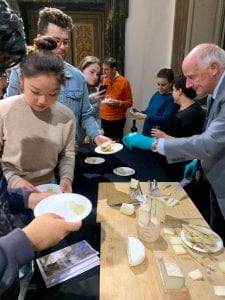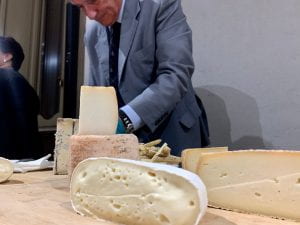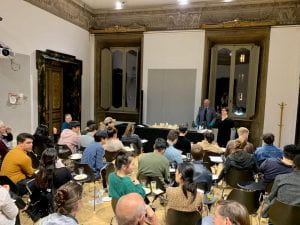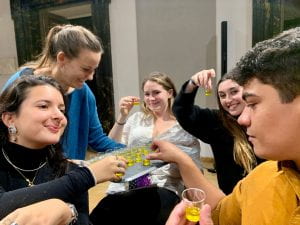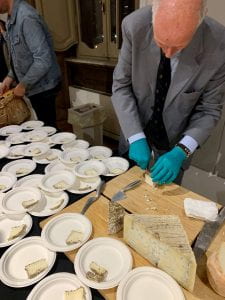Cornell students had the unique experience of an oil and cheese tasting by professional taster Roberto Bigollo. Italians are the world’s top consumers of olive oil, and it’s no secret their cheeses are delicious. We start with the oil, and Mr. Bigollo explains that the cheap olive oil we buy at the grocery store is made by reducing the acidity of low quality oils! Luckily, he proceeded to give us the tools to tell the difference between processed oil and quality, fresh olive oil.
He first explains that the color of the oil says nothing of the quality, it’s all about the taste: To get the full taste of the oil you have to warm up it up by upping your cupping your hands around the glass. Then you put bit under your tongue and suck air through your teeth; this brings out the spice and bitterness of the oil.
First we taste an oil from Trieste described as balanced between sweet and spicy, fruity with hints of grass. Next, we try an oil from Lazio, in which we reside, described as rich, bitter and spicy.
The last one we taste is your usual cheap grocery store oil, and low and behold this one burned!
The oil tasting was interesting, but we were all heavily anticipating the cheese. Mr. Bigollo explained that the origins of cheese came from a need to do something with milk which expires after just 5 days.
The first cheese we try is a soft creamy cow’s milk cheese called Fiocco Della Tuscia. It looked a lot like Brie, and I learned that the white layer that forms around these cheeses is a mold called patina.
The next cheese, Taleggio di Bufala, is also soft but not as creamy as the last one. As the name suggests, it is made from buffalo’s milk. This cheese ripens on wood and needs to washed every day in the making process. It’s a bit tangier and very earthy.
Then we try Cacioricotta di Capra which is a unique cheese because it keeps it serum. Serum is a protein that is usually taken out of cheese and then made to create ricotta. In this cheese, the casein and serum proteins coagulate together. It is made of goat’s milk and is much sharper than the rest.
The last two cheeses are served with white wine and bread from all of our favorite bakery— Roscioli!!!
Not gonna lie, these cheeses were pretty weird. There was a sheep’s milk cheese encased by 16 different aromatic herbs to keep from going bad. Fun fact: back in the day the herbs weren’t just for preserving the cheese but from hiding the smell from others who might eat to steal it.
Another was a super moldy and pungent blue cheese. I still don’t understand why what is technically expired moldy milk is so delicious, but, hey, I’m not complaining.
written by Margaret Groton
photography by Lauren Peters


